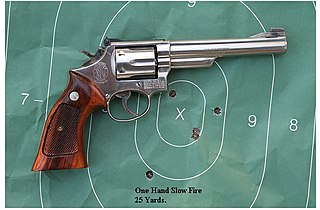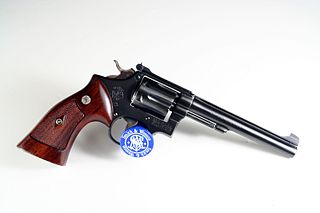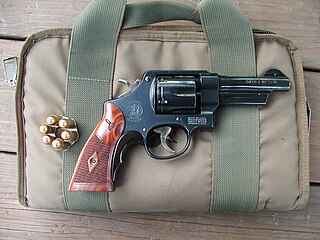
A revolver is a repeating handgun that has at least one barrel and uses a revolving cylinder containing multiple chambers for firing. Because most revolver models hold up to six cartridges before needing to be reloaded, revolvers are also commonly called six shooters.

The .38 Special, also commonly known as .38 S&W Special, .38 Smith & Wesson Special, .38 Spl, .38 Spc,, or 9x29mmR is a rimmed, centerfire cartridge designed by Smith & Wesson.

The Smith & Wesson Model 29 is a six-shot, double-action revolver chambered for the .44 Magnum cartridge and manufactured by the United States company Smith & Wesson.

The 10mm Auto is a semi-automatic pistol cartridge introduced in 1983. Its design was adopted and later produced by ammunition manufacturer FFV Norma AB of Åmotfors, Sweden.

The .32 S&W Long, also known as 7.65x23mm, is a straight-walled, centerfire, rimmed handgun cartridge, based on the earlier .32 S&W cartridge. It was introduced in 1896 for Smith & Wesson's first-model Hand Ejector revolver. Colt called it the .32 Colt New Police in revolvers it made chambered for the cartridge.

The Smith & Wesson Model 19 is a revolver produced by Smith & Wesson that was introduced in 1957 on its K-frame. The Model 19 is chambered for .357 Magnum. The K-frame is somewhat smaller and lighter than the original N-frame .357, usually known as the Smith & Wesson Model 27. A stainless steel variant of the Model 19, the Smith & Wesson Model 66, was introduced in 1971.

The Smith & Wesson Model 10, previously known as the Smith & Wesson .38 Hand Ejector Model of 1899, the Smith & Wesson Military & Police or the Smith & Wesson Victory Model, is a K-frame revolver of worldwide popularity. In production since 1899, the Model 10 is a six-shot, .38 Special, double-action revolver with fixed sights. Over its long production run it has been available with barrel lengths of 2 in (51 mm), 3 in (76 mm), 4 in (100 mm), 5 in (130 mm), and 6 in (150 mm). Barrels of 2.5 inches (64 mm) are also known to have been made for special contracts. Some 6,000,000 of the type have been produced over the years, making it the most produced handgun of the 20th century.

A moon clip is a ring-shaped or star-shaped piece of metal designed to hold multiple cartridges together as a unit, for simultaneous insertion and extraction from a revolver cylinder. Moon clips may either hold an entire cylinder's worth of cartridges together, half a cylinder, or just two neighboring cartridges. The two-cartridge moon clips can be used for those revolvers that have an odd number of loading chambers such as five or seven and also for those revolvers that allow a shooter to mix both rimless and rimmed types of cartridges in one loading of the same cylinder.

The Smith & Wesson Model 586, is a six- or seven-shot double-action revolver chambered for the .357 Magnum cartridge; it will also chamber and fire .38 Special cartridges. The Model 586 has a carbon steel construction and is available in a blued or nickel finish; it is essentially the same firearm as the Model 686, which has stainless steel construction. It is also known as the Distinguished Combat Magnum.

The Smith & Wesson Model 686 is a six- or seven-shot double-action revolver manufactured by Smith & Wesson and chambered for the .357 Magnum cartridge; it will also chamber and fire .38 Special cartridges. Smith & Wesson introduced the Model 686 in 1981. It is the stainless steel version of the Model 586, which featured a blued steel finish. They are available ported and unported with a choice of 6- or 7-round cylinders.

The Smith & Wesson Model 625, is a six-round, double-action revolver chambered for the .45 ACP using moon clips. The Model 625 is an improved stainless steel version Smith & Wesson Model 22 and a direct descendant of the Smith & Wesson M1917 revolver first issued during World War I.

The M1917 Revolvers were six-shot, .45 ACP, large frame revolvers adopted by the United States Military in 1917, to supplement the standard M1911 pistol during World War I. There were two variations of the M1917, one made by Colt and the other by Smith & Wesson. They used moon-clips to hold the cartridges in position, facilitate reloading, and to aid in extraction since revolvers had been designed to eject rimmed cartridges and .45 ACP rounds were rimless for use with the magazine-fed M1911. After World War I, they gained a strong following among civilian shooters. A commercial rimmed cartridge, the .45 Auto Rim, was also developed, so M1917 revolvers could eject cartridge cases without using moon-clips.

In American English, a pocket pistol is any small, pocket-sized semi-automatic pistol, and is suitable for concealed carry in a pocket or similar space.

The Smith & Wesson Model 17 is a six-shot double-action revolver chambered for .22 LR. It is built on Smith & Wesson's medium-sized K-frame.

A snubnosed revolver is a small, medium, or large frame revolver with a short barrel, generally less than 4 inches in length. Smaller such revolvers are often made with "bobbed" or "shrouded" hammers and there are also "hammerless" models ; the point is to allow the gun to be drawn with little risk of it snagging on clothing. Since the external movement of the mechanism is minimal or nil, shrouded and hammerless models may be fired from within clothing. The design of these revolvers compromises range and accuracy at a distance in favor of maneuverability and ease of carry and concealment.

S&W Centennial is a family of revolvers made by Smith & Wesson on the "J-Frame". Depending upon caliber, the cylinder holds either 5, 6, 7, or 8 cartridges. Centennials feature a fully enclosed (internal) hammer, which makes them Double Action Only (DAO) firearms. Like all other "J-frame" Smith & Wesson revolvers, they have a swing-out cylinder. Centennial models have been made in different versions like PD "Personal Defense", LS "Lady Smith", and M&P "Military & Police"

A handgun is a firearm designed to be usable with only one hand. It is distinguished from a long gun which needs to be held by both hands and braced against the shoulder. The two most common types of handguns are revolvers and semi-automatic pistols, although other types such as derringers and machine pistols also see infrequent usage.

The Smith & Wesson Model 22 is a 6-shot, double-action, large frame revolver chambered in .45 ACP using moon clips. It's a refined commercial version of the M1917 revolver first issued during World War I.
The Smith & Wesson Model 646 is a six-shot, double-action revolver chambered for the .40 S&W pistol cartridge, manufactured in 2000 and 2003 by the United States company Smith & Wesson.

The Smith & Wesson Governor is a snub-nosed single-action/double-action revolver built on the Z-frame and utilizes a K-frame grip with a lightweight scandium alloy or stainless steel frame.




















